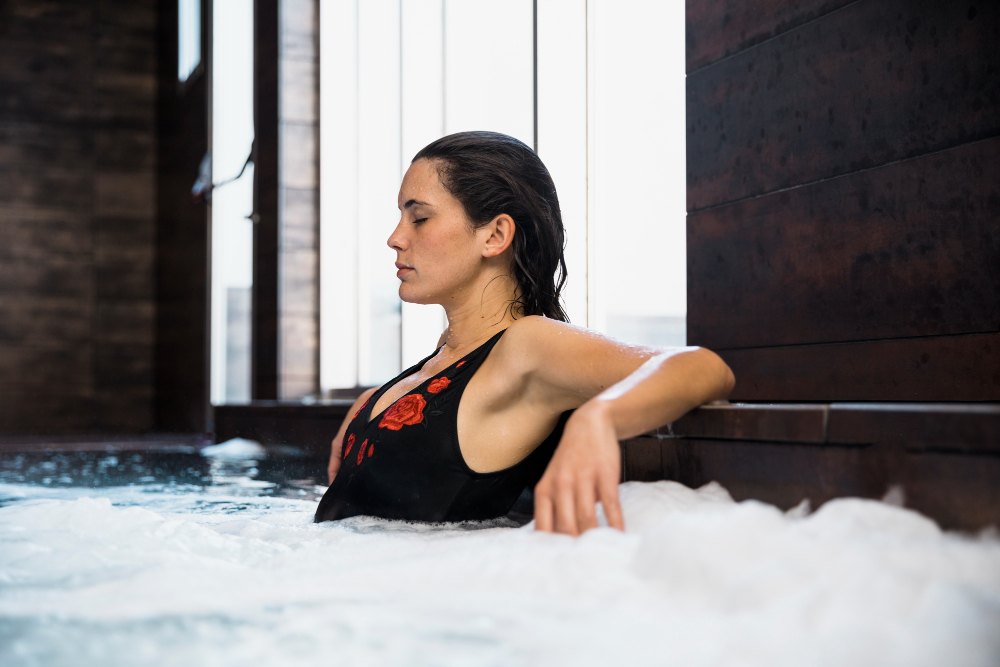Introduction
In the quest for improved recovery, performance enhancement, and overall well-being, ice baths and whole-body cryotherapy have emerged as prominent modalities in the realms of sports, fitness, and wellness. Both practices are renowned for their ability to alleviate muscle soreness, reduce inflammation, and enhance recovery after intense physical activity. However, despite their shared goals, ice baths and cryotherapy operate through distinct mechanisms and offer unique benefits. This article delves into the comparative analysis of ice baths and whole-body cryotherapy, exploring their similarities and differences, including their physiological effects, benefits, and mechanisms of action.
What are Ice Baths?
Ice baths, also known as cold water immersion (CWI), involve immersing the body in cold water, typically between 4°C to 15°C (39°F to 60°F), for a period of 3 to 15 minutes. This practice is commonly used by athletes and fitness enthusiasts to speed up recovery after intense physical exertion. Many other benefits of ice bath and cold exposure have been scientifically proven and experience by many people.
Mechanism of Action
The primary mechanism through which ice baths exert their effects is by inducing vasoconstriction, the narrowing of blood vessels. This response reduces blood flow to the immersed areas, decreasing inflammation and metabolic activity. The cold exposure also stimulates the nervous system, leading to reduced pain perception and a subsequent decrease in muscle soreness.
What is Whole-Body Cryotherapy?
Whole-body cryotherapy (WBC) involves exposing the body to extremely cold air, typically between -110°C to -140°C (-166°F to -220°F), for a short duration, usually between 2 to 4 minutes. Originating in Japan in the 1970s, cryotherapy has gained popularity worldwide, particularly among athletes, celebrities, and health enthusiasts.
Mechanism of Action
Cryotherapy triggers a systemic response by exposing the body to extreme cold. Unlike ice baths that cause direct cooling of the tissues, cryotherapy cools the body’s surface, which leads to a central decrease in body temperature. This process initiates a survival response, leading to the release of endorphins and a rapid circulation of oxygen-rich blood throughout the body once the session ends. The extreme cold also reduces the activity of pro-inflammatory molecules, thereby decreasing inflammation and pain.
Similarities between Ice Baths and Cryotherapy
- Pain and Inflammation Reduction: Both modalities are effective in reducing pain and inflammation. They achieve this by altering blood flow, decreasing tissue temperature, and reducing the activity of inflammatory mediators.
- Recovery Enhancement: Athletes and physically active individuals use both ice baths and cryotherapy to enhance recovery from muscle damage induced by exercise.
- Nervous System Stimulation: Both treatments stimulate the nervous system, which can lead to decreased pain perception and a feeling of rejuvenation.
Differences between Ice Baths and Cryotherapy
- Temperature and Exposure Time: Cryotherapy involves shorter exposure times at much lower temperatures compared to ice baths. While the extreme cold in cryotherapy does not directly cool the body’s core temperature significantly due to the short exposure time, ice baths involve prolonged direct contact with cold water, leading to a more substantial decrease in tissue temperature.
- Deeper Tissue Cooling: Ice baths allow for a more profound and sustained cooling effect on the tissues, leading to more significant reduction in muscle soreness and inflammation. Cryotherapy’s short exposure time and indirect cooling may not penetrate as deeply into the muscles and tissues, potentially leading to less effective inflammation and pain reduction.
- Enhanced Muscle Recovery: The prolonged exposure to cold water helps in the more effective flushing out of metabolic waste from muscles, thereby speeding up recovery.
- Cardiovascular Improvements: Regular use of ice baths can improve cardiovascular health by enhancing blood circulation and strengthening the heart muscles.
- Mental Resilience: The practice of immersing oneself in cold water can improve mental toughness and stress resilience. That Is not the case with Cryotherapy as it does not create the same level of initial shock as a cold plunge.
- Accessibility and Cost: Ice baths can be easily prepared at home with ice and water, making them more accessible and cost-effective. In contrast, cryotherapy requires specialized equipment and facilities, often leading to higher costs and limited accessibility.
- Risk of Frostbite and Burns: The extremely low temperatures used in cryotherapy can pose a risk of frostbite or burns if not properly administered.
- Lack of Long-Term Research: There is less long-term research on the effects of cryotherapy, leading to uncertainties about its benefits and potential risks.
Conclusion
While ice baths and whole-body cryotherapy share common goals in reducing pain, inflammation, and enhancing recovery, they differ significantly in their mechanisms, physiological responses, and practical considerations. Ice baths provide a more accessible and targeted approach to muscle recovery, whereas cryotherapy offers a quick, systemic treatment with a range of physiological benefits. Ultimately, the choice between ice baths and cryotherapy should be based on individual needs, preferences, and specific health and fitness goals.
Here are our recommendations for some of the finest Ice Bath & Cold Plunge:


![The Rise of Loan Affiliate Marketing: Strategies That Actually Work The financial affiliate industry has seen explosive growth in recent years, with loan products becoming one of the most profitable verticals. As consumers increasingly turn to digital platforms for financial assistance, loan affiliate marketing is emerging as a reliable and scalable income stream for savvy affiliates. In this article, we’ll explore why loan affiliate marketing is growing so rapidly, which strategies are working best in 2025, and how Lead Stack Media — the USA’s best loan affiliate program — helps marketers dominate this niche. What Is Loan Affiliate Marketing? Loan affiliate marketing is a performance-based model in which affiliates promote financial loan products — such as personal loans, payday loans, or installment loans — and earn commissions for generating leads, completed applications, or approved borrowers. Affiliates typically drive traffic through: SEO and content marketing Paid advertising (Google Ads, native ads) Social media funnels Email marketing campaigns When done right, loan affiliate marketing can deliver high conversions and substantial payouts, especially with access to exclusive offers. Why Loan Affiliate Marketing Is Booming in 2025 Several factors are contributing to the rise of this high-value affiliate vertical: 1. Increased Demand for Digital Lending Millions of Americans are seeking quick access to funds — often online and without traditional banking hurdles. This has created a consistent, evergreen demand for personal and payday loan products. 2. High-Payout Offers Loan affiliate offers often pay $75–$250+ per approved lead. Compared to other verticals, this makes finance one of the most rewarding for affiliates. 3. Multiple Sub-Niches You can target a wide range of borrowers: Bad credit loans Emergency cash loans Student loans Debt consolidation No credit check loans 4. Data-Driven Optimization With modern tracking tools and split testing, affiliates can scale profitable campaigns quickly. Networks like Lead Stack Media provide real-time analytics to refine every aspect of your funnel. The Foundation: Choosing the Right Affiliate Partner The network you choose plays a huge role in your success. Many affiliates fail because they join general networks with low-converting, saturated offers. Instead, opt for a specialized and trusted program like Lead Stack Media, which offers: ✅ Exclusive, high-converting loan campaigns ✅ Weekly payouts and strong EPCs ✅ Custom creatives and funnel templates ✅ Legal and compliance support ✅ Dedicated affiliate managers who care about your growth Lead Stack Media is regarded as the top loan affiliate program in the USA — and for good reason. Top Strategies That Actually Work in Loan Affiliate Marketing Now let’s dive into the proven strategies that successful affiliates are using to win big in 2025: 1. SEO-Driven Content Marketing Search Engine Optimization (SEO) is a long-term strategy that offers compounding returns. Focus on ranking for keywords with high intent and low competition, such as: “Best loans for bad credit in [2025]” “Apply for emergency loan online” “Get $2,000 loan today – no credit check” Create in-depth blog posts, product reviews, and loan comparison articles. Include CTAs and banners that drive traffic to exclusive offers from Lead Stack Media. Pro Tip: Use schema markup, FAQ sections, and internal linking to boost visibility in Google search results. 2. Native Ads & Advertorial Funnels Native advertising via platforms like Taboola, Outbrain, or Revcontent allows you to blend your ads into the look and feel of editorial content. Pair your native ad with a pre-sell article (also known as an advertorial), such as: “How This Mother of Two Got a $3,000 Loan Approved in 10 Minutes” Drive readers to a Lead Stack Media landing page with a compelling CTA like “Check Your Loan Eligibility Now.” Native ads tend to have high engagement and lower CPCs than traditional display or search ads. 3. Paid Search Campaigns (Google Ads) If you're experienced with Google Ads, targeting high-intent keywords in the loan space can bring massive returns. Focus on: Keyword match types (exact and phrase) Localized targeting (state or city-based campaigns) Strong ad copy with compliance built-in Mobile-first landing pages Lead Stack Media provides ad copy examples and guidance to help you stay compliant and profitable. 4. List Building and Email Marketing Building a list of subscribers allows you to: Promote multiple loan products over time Segment based on user behavior (clicks, opens, interest) Re-engage non-converting leads through drip sequences Send 3–5 follow-up emails after a lead opts in with subject lines like: “You May Still Qualify for a $2,500 Loan – No Hard Credit Check Required” Note: Always follow CAN-SPAM and GDPR guidelines. 5. Funnel Optimization and Retargeting A fully optimized funnel makes the difference between a breakeven campaign and one that earns $1,000+ per day. Use retargeting via: Facebook Pixel Google Display Network Email re-engagement You can also optimize your landing page by testing: Button colors Trust badges (SSL, testimonials) Loan amount sliders Short vs long form CTAs Lead Stack Media provides A/B-tested pages and custom funnel support for all affiliates. Common Mistakes to Avoid in Loan Affiliate Marketing Even experienced marketers sometimes struggle in the loan niche. Avoid these pitfalls: ❌ Promoting non-compliant or misleading offers ❌ Sending traffic directly to the lender without warming them up ❌ Not segmenting traffic based on device or credit tier ❌ Ignoring data and failing to optimize campaigns Working with a high-quality network like Lead Stack Media eliminates many of these problems by giving you compliant offers, support, and tools right out of the box. Why Lead Stack Media Is the Best Choice for Loan Affiliates Thousands of affiliates trust Lead Stack Media because the platform was built by performance marketers, for performance marketers. What makes them the best in class? ✅ Exclusive access to top loan offers you won’t find on public affiliate networks ✅ Advanced tracking systems with real-time reporting ✅ Weekly payments via ACH, PayPal, or crypto ✅ Hands-on account managers who provide real business coaching ✅ Custom landing pages, email creatives, and ad templates ✅ Compliance support and pre-approved marketing materials Whether you’re new or experienced, Lead Stack Media helps you start fast and scale big. The Future of Loan Affiliate Marketing In 2025 and beyond, loan affiliate marketing will continue to grow as financial technology and consumer demand intersect. Here’s what to expect: Greater personalization of offers based on credit profile and geography AI-powered ad testing and lead scoring Deeper integration with BNPL (Buy Now Pay Later) and fintech solutions Stricter regulations — making compliant offers from trusted networks even more valuable If you want to stay ahead of the curve, now is the time to double down on this vertical — and partner with the right affiliate network. Conclusion: Start Winning in the Loan Vertical Today The rise of loan affiliate marketing is not a fluke — it’s a result of high consumer demand, attractive payouts, and accessible digital tools. But not every affiliate program is built for long-term success.](https://www.factsnews.co/wp-content/uploads/2025/06/121234-768x546.jpg)

